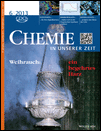Mikrowellen in der Organischen Synthese
Manche mögens heiß
Abstract
deDas kontrollierte Mikrowellen-Heizen, besonders die Variante in geschlossenen Reaktionsgefäßen, bietet viele Vorzüge gegenüber traditionell beheizten Synthesen. Schnellere Reaktionszeiten, höhere Ausbeuten und bessere Reproduzierbarkeit zählen wohl zu den Wichtigsten. Außerdem kann die Mikrowellensynthese leicht an eine parallele oder automatisierte sequenzielle Arbeitsweise angepasst werden. Aufgrund der einfachen Handhabung der Mikrowellentechnologie und der Tatsache, dass man für eine bestimmte chemische Umwandlung binnen 5–10 Minuten ein aussagekräftiges Ergebnis (“Ja” oder “Nein”) erhalten kann, wird diese neuartige Heizmethode bereits an vielen Universitäten und in der Industrie vor allem zur schnellen Reaktionsoptimierung und zur effizienten Synthese neuer Verbindungen genutzt.
Abstract
enControlled microwave heating, in particular using sealed-vessel systems, offers many advantages over traditionally heated syntheses. As most important ones are considered: reduced reaction times, higher yields and reproducibility. In addition, it can rapidly be adapted to a parallel or automated sequential processing format. Because of the convenience of microwave technology and the fact that a “yes or no answer” for a particular chemical transformation can often be obtained within 5 to 10 minutes, this heating method is an efficient tool for many academic and industrial research groups. There it is primarily used for rapid reaction optimization and efficient synthesis of new chemical entities.




